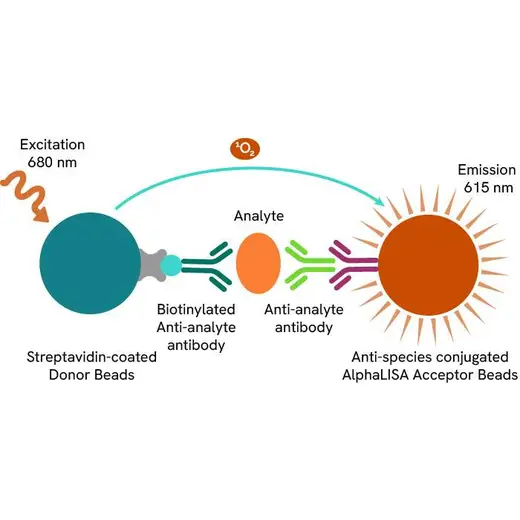
AlphaLISA Human IgG4 (Isotyping) Detection Kit, 500 Assay Points


 View All
View All
AlphaLISA Human IgG4 (Isotyping) Detection Kit, 500 Assay Points










The AlphaLISA Human IgG4 Detection Kit is designed for detection, quantitation, and isotyping of human IgG4 in cell culture medium and non-human serum, using a homogeneous (no wash steps, no separation steps) assay. The assay shows negligible cross-reactivity with other human IgG isotypes and monkey IgG.
For research use only. Not for use in diagnostic procedures. All products to be used in accordance with applicable laws and regulations including without limitation, consumption and disposal requirements under European REACH regulations (EC 1907/2006).
| Feature | Specification |
|---|---|
| Application | Protein Quantification |
| Dynamic Range | 300 - 500,000 pg/mL |
| Limit of Detection | 300 pg/mL |
| Limit of Quantification | 600 pg/mL |
| Sample Volume | 5 µL |
The AlphaLISA Human IgG4 Detection Kit is designed for detection, quantitation, and isotyping of human IgG4 in cell culture medium and non-human serum, using a homogeneous (no wash steps, no separation steps) assay. The assay shows negligible cross-reactivity with other human IgG isotypes and monkey IgG.
For research use only. Not for use in diagnostic procedures. All products to be used in accordance with applicable laws and regulations including without limitation, consumption and disposal requirements under European REACH regulations (EC 1907/2006).





AlphaLISA Human IgG4 (Isotyping) Detection Kit, 500 Assay Points





AlphaLISA Human IgG4 (Isotyping) Detection Kit, 500 Assay Points





Product information
Overview
Formats:
- Our HV (100 assay point) kits allow you to run 100 wells in 96-well format, using a 100 µL reaction volume (10 µL of sample).
- Our 500 assay point kit allows you to run 500 wells in 96-well or 384-well format, using a 50 µL reaction volume (5 µL of sample).
- Our 5,000 assay point kit allows you to run 5,000 wells in 96-well or 384-well format, using a 50 µL reaction volume (5 µL of sample).
Features:
- No-wash steps, no separation steps
- ELISA alternative technology
- Sensitive detection
- Broad sample compatibility
- Small sample volume
- Results in less than 3 hours
- Half the time of an ELISA assay
Immunoglobulin G (IgG) is a major effector molecule of the humoral immune response and accounts for about 75% of the total immunoglobulins in plasma of healthy individuals. The remainder 25% comprises IgM, IgA, IgD and IgE, each of which has characteristic properties and functions. The basic IgG molecule has a four-chain structure, comprising two identical heavy (H) chains and two identical light (L) chains, linked together by inter-chain disulfide bonds. Four IgG subclasses have been identified: IgG1, IgG2, IgG3 and IgG4.
AlphaLISA technology allows the detection of molecules of interest in a no-wash, highly sensitive, quantitative assay. In an AlphaLISA assay, a biotinylated anti-analyte antibody binds to the Streptavidin-coated Donor beads while another anti-analyte antibody is conjugated to AlphaLISA Acceptor beads. In the presence of the analyte, the beads come into close proximity. The excitation of the Donor beads causes the release of singlet oxygen molecules that triggers a cascade of energy transfer in the Acceptor beads, resulting in a sharp peak of light emission at 615 nm.
Specifications
| Application |
Protein Quantification
|
|---|---|
| Automation Compatible |
Yes
|
| Brand |
AlphaLISA
|
| Detection Modality |
Alpha
|
| Dynamic Range |
300 - 500,000 pg/mL
|
| Limit of Detection |
300 pg/mL
|
| Limit of Quantification |
600 pg/mL
|
| Product Group |
Kit
|
| Sample Volume |
5 µL
|
| Shipping Conditions |
Shipped in Blue Ice
|
| Target |
IgG4
|
| Target Class |
Biologics
|
| Target Species |
Human
|
| Technology |
Alpha
|
| Unit Size |
500 Assay Points
|
Video gallery

AlphaLISA Human IgG4 (Isotyping) Detection Kit, 500 Assay Points

AlphaLISA Human IgG4 (Isotyping) Detection Kit, 500 Assay Points

Resources
Are you looking for resources, click on the resource type to explore further.
With over 200 different types of cancer, management relies on a variety of techniques such as chemotherapy, radiotherapy, and...


How can we help you?
We are here to answer your questions.






























